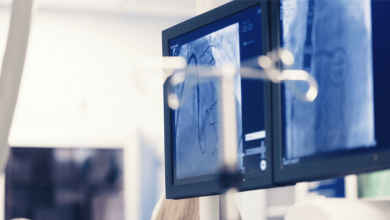Search results
Author(s):
Kimberly Atianzar
,
Peter Casterella
,
Ming Zhang
,
et al
Added:
3 years ago
The foramen ovale is an important fetal structure that is integral to fetal circulation. During fetal development days 30–37, intra-atrial endothelial cells proliferate to form the septum primum and the ostium primum. The overlap between the these structures forms the inter-atrial passage known as the foramen ovale,1,2 which allows the fetal lungs to be bypassed by facilitating fetal blood…
View more
Author(s):
Carlos Vazquez-Sosa
,
Stacey D Clegg
,
James C Blankenship
Added:
2 years ago
Lars Søndergaard
Research Area(s) / Expertise:
Author
Carlos Morillo
Author
Author(s):
Barry Love
Added:
3 years ago
Children and adults with congenital heart disease are increasingly benefiting from non-surgical alternatives to repair their heart defects. The last decade has seen a remarkable advance in the tools and techniques used to treat congenital heart disease in the cardiac catheterization laboratory. This article summarizes a few of the important tools available in 2005.
Atrial Septal Defect
Secundum…
View more
Author(s):
Braghadheeswar Thyagarajan
,
Ankur Kalra
,
Alefiyah Rajabali
,
et al
Added:
3 years ago
Atrial fibrillation (AF) is the most common arrhythmia in patients with hypertrophic cardiomyopathy (HCM), with a reported prevalence of AF in HCM of about 25 %.1 Patients with AF in HCM tend to be more symptomatic and have an increased stroke risk compared with patients without HCM.2 While the occurrence and treatment of (symptomatic) AF in HCM have been extensively studied, there is little data…
View more
Author(s):
Michael C Slack
Added:
3 years ago
This is certainly an exciting time to be a congenital interventional cardiologist. No doubt the later part of the 20th century laid the foundation for the new millennium; however, since the centennial celebration, several milestone events have already occurred and the future looks as bright as ever. In late 2001, the Amplatzer Atrial Septal Occluder System┬«, became the first device ever to…
View more
Author(s):
Duraisamy Balaguru
,
Rajiv Verma
Added:
3 years ago
Surgical repair has been the cornerstone of treatment for congenital heart diseases (CHD). However, cardiac catheterization has evolved from being a diagnostic modality to a therapeutic one in the past four decades. Application of catheter-based therapy has become the standard of care for some congenital heart defects, thus obviating surgery. This review will discuss congenital heart defects that…
View more
Author(s):
Steven Zweibel
,
Melissa Trelfa
Added:
3 years ago
Continuous outpatient monitoring of a patient’s heart rhythm was initiated in 1949 with the invention of the Holter monitor by Norman J Holter. The early systems were bulky, recorded the heart’s rhythm for 24 or 48 hours onto a tape or cassette, and required that the data be analyzed by a technician after completion of the recording. As technology advanced, smaller devices (event recorders) were…
View more
Author(s):
Sara C Martinez
,
Sharonne N Hayes
Added:
3 years ago
Pregnancy is a physiologic challenge, with significant hormonal, metabolic, and hemodynamic changes. Cardiac output is objectively increased by the fifth week after the last menstrual period and continues to grow by approximately 45 % by 24 weeks in the normal, singleton pregnancy. This is facilitated by elevations in heart rate and stroke volume and a decrease in systemic vascular resistance…
View more













